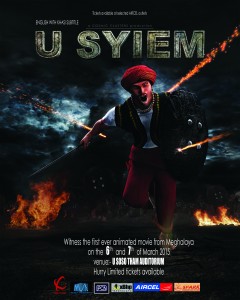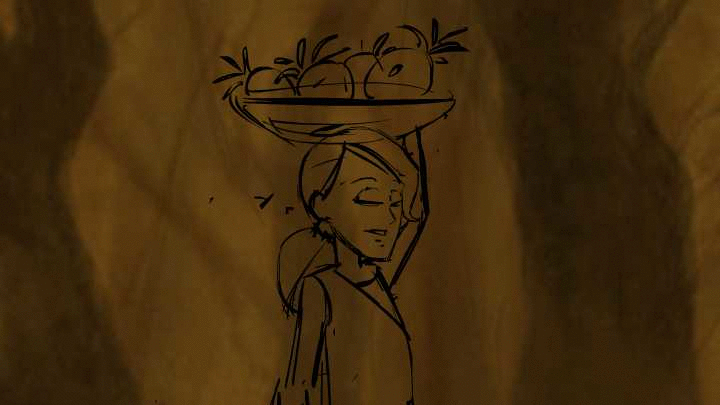
A freedom fighter is going to rise again. But this time it will be from the northeastern part of India – the state of Meghalaya. A Khasi fighter U Tirot Sing will be shown in the form of an animated 3D film depicting his struggle against British invasion in the nineteenth century.
Under the banner of Cosmic Clusters, U Syiem is an upcoming animated movie from the state which is about 60 minutes long and has been produced at a cost of Rs 32 lakh. The word ‘Syiem’ means chief or king in Khasi. Speaking exclusively to AnimationXpress.com, film director Ban Casper Mawlong expounds that the idea came to him when he met M Janai N Talang. The former left his job as a senior animator in an animation studio and joined hands with M Janai, who quit his position as VFX specialist at an Advertising agency. Together they set up Cosmic Clusters.
“Cosmic Clusters started in a small flat in Kolkata which we later shifted to Shillong. We managed to find outsourced work and save a bit of money to start pre-production and research on a real hero, so I thought why not make a movie on a freedom fighter, with proper planning and script the budget of the film could be reduced to the lowest ever CGI film from the country, that will be at par to the quality of earlier films at least. Little did we know that we are going to face many challenges ahead,” he informs.
Considering the amount of battle scenes, soldiers, props and 19th century environment that needed to be captured, the shoestring budget that they were working on made it impossible to go with a live-action format. Therefore animation was the preferred medium. “We chose 3D because we can play around with the camera angle, dynamics, look and feel. It is also better suited to represent a historical story,” he explains on choosing animation as the medium for telling the story.

The animation team of six consisted of three artists and three freelancers; Ban Casper is also the storyboard artist, animator and editor of the movie while M Janai has worked on the environment modeling, texturing, lighting, rigging, FX, dynamics, compositing and rendering. Animation supervision was under the purview of Souvik Majumdar and illustration and storyboard were overseen by Deep Jyoti Deka and Jesse Allester. This apart, 34 people worked on the music and voice-over production.
Ban Casper says that a lot of research went on for a year in pre-production to get facts right by reading books, travelling to places where the culture is still prevalent and by also visiting museums. After this, the team took a year to create the script and dialogues. “The team believed that a narrative style of 60 per cent action and 40 per cent dialogues was better. While the story is inspired by actual events certain characters, location, dialogues were fictionalised for the purpose of dramatisation,” he adds. He also visited the descendant of U Tirot Sing, who helped them make corrections to their scripts for certain historical facts.
The animation took the next one year with music being provided by Gregory Syiem. The project is self financed by simultaneously working on freelance projects from abroad and includes pre-production, post-production and music. They also used Blender to create the animation to save cost. “Honestly we could have done better with the animation quality and also the overall look and feel provided if we had 40 per cent more budget from the present one,” he says.

Although, they have tried to replicate the two century old setting, due to budget constraints and time factor they had to tone down the clothing dynamics. The battle scenes were also tough to execute as per Ban Casper because of the heavy usage of crowd multiplication leading to long rendering, animation and compositing process time. During character development, jewelry and clothing were also toned down keeping in mind the rendering process.
The movie will first be released in English to reach a larger audience with a Khasi dubbed version later on. The catalyst for him to create the movie was to educate the younger generation who were unaware about him and thought of him to be a Punjabi ‘Singh’.
Without approaching any distributors yet, the aim is to screen the movie in schools and colleges in the state as well as hold special screenings. The movie will be unveiled in a special premiere on 6 and 8 March. The state or national government hasn’t provided any aid to the project yet. Ban Casper is also aware of the risk associated with the movie. “We knew it is going to be a big risk but if we get our calculations right we would be able to recover the cost of producing and also make it a profitable venture,” he says confidently.
A tie up with Aircel will give publicity through SMS, A3 posters and standees. Merchandising will include T-shirts, frames and limited edition posters during the premiere of the movie at selected malls. “Aircel our Telecom partner was the only one showing interest in promoting the movie at least in Meghalaya,” says Ban Casper.
The studio has managed to keep a check on the budget (which it expects to recover) while also catering to a universal audience; using open source softwares. “Our colleagues said it is impossible to make an entire animated feature film with just two people when good ones need at least 250 people including financers and producers,” Ban Casper exults. After four failed attempts of executing a pipeline, they managed a breakthrough in 2013. Only time will tell if this period film can manage to replicate the success of the Harry Baweja directed Chaar Sahibzaade which released in 2014 and went onto not just create box-office records but also showed the coming of age of the Indian animation industry.